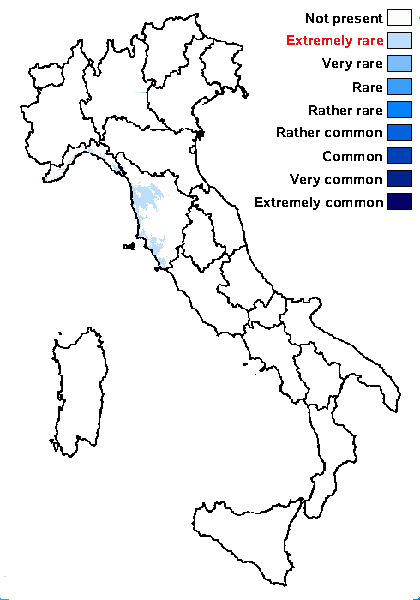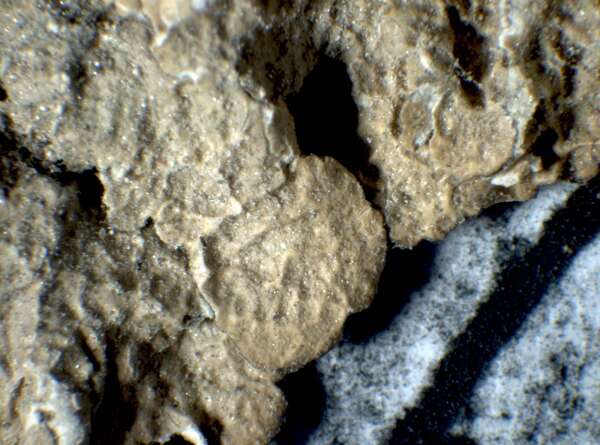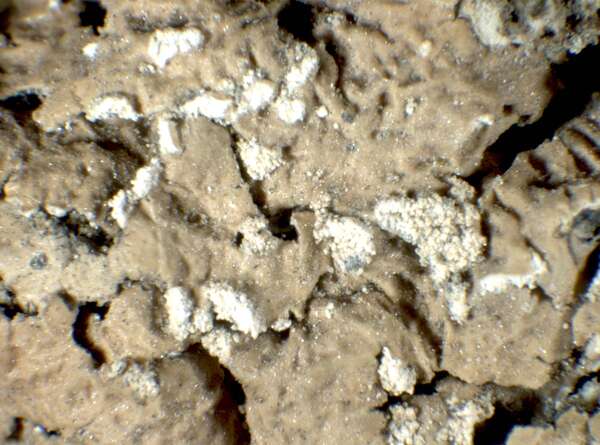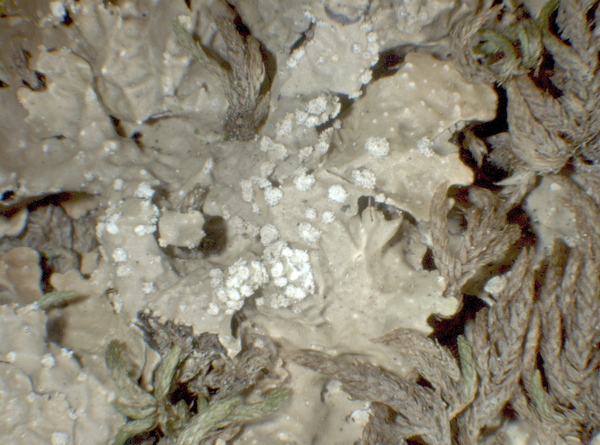Punctelia perreticulata (Räsänen) G. Wilh. & Ladd
Mycotaxon, 28: 249, 1987. Basionym: Parmelia duboscqii Abbayes var. perreticulata Räsänen in Sbarbaro - Ann. Mus. Civ. Storia Nat. Genova, 41: 40, 1941.
Synonyms: Parmelia perreticulata (Räsänen) Hale
Distribution: N - Lig (Gyelnik Lichenoth. Parva 72: Adler & Ahti 1996, Longàn & al. 2000, Leandrin 2004, Giordani & Incerti 2008, Lendemer & Hodkinson 2010). C - Tosc (Tretiach & al. 2002, Leandrin 2004).
Description: Thallus foliose, heteromerous, dorsivental, forming 6(-8) cm wide rosettes, sorediate. Lobes contiguous, 1-6 mm wide, bluish grey to greenish grey, usually pruinose especially at margins and tips, the margins often tinged brown, ridged and foveolate-scrobiculate, with a few, white, mainly marginal, rounded to elliptical pseudocyphellae; soralia white, mostly marginal, crescent-shaped, sometimes confluent. Lower surface white at margin, pale brown in central parts, with simple to weakly forked, concolorous rhizines. Upper cortex paraplectenchymatous, of 2-6 layers of densely packed cells, with a non-pored epicortex, the cell walls with isolichenan; medulla white; algal layer continuous; lower cortex paraplectenchymatous. Apothecia very rare, lecanorine, up to 6 mm across, with a dark brown disc and an often sorediate thalline margin. Proper exciple thin, colourless; epithecium brownish; hymenium and hypothecium colourless. Asci 8-spored, clavate, Lecanora-type. Ascospores 1-celled, hyaline, ovoid to ellipsoid, 12-16 x 6-9 µm. Pycnidia black, semi-immersed. Conidia filiform, 6-11 x c. 1 µm. Photobiont chlorococcoid. Spot tests: upper cortex K+ yellow, C-, KC-, P-; medulla K-, C+ red, KC+ red. Chemistry: upper cortex with atranorin; medulla with lecanoric acid. Note: a mainly Mediterranean-Atlantic lichen found on siliceous rocks and bark, restricted to Tyrrhenian Italy. It is included in the Italian red list of epiphytic lichens as “Endangered” (Nascimbene & al. 2013c).
Growth form: Foliose, broad lobed
Photobiont: green algae other than Trentepohlia
Reproductive strategy: mainly asexual, by soredia, or soredia-like structures (e.g. blastidia)
Most common in areas with a humid-warm climate (e.g. most of Tyrrenian Italy)
Commonnes-rarity: (info)
Alpine belt: absent
Subalpine belt: absent
Oromediterranean belt: absent
Montane belt: absent
Submediterranean belt: absent
Padanian area: absent
Humid submediterranean belt: absent
Humid mediterranean belt: extremely rare
Dry mediterranean belt: absent

Predictive model
Herbarium samples
Growth form: Foliose, broad lobed
Photobiont: green algae other than Trentepohlia
Reproductive strategy: mainly asexual, by soredia, or soredia-like structures (e.g. blastidia)
Most common in areas with a humid-warm climate (e.g. most of Tyrrenian Italy)
Commonnes-rarity: (info)
Alpine belt: absent
Subalpine belt: absent
Oromediterranean belt: absent
Montane belt: absent
Submediterranean belt: absent
Padanian area: absent
Humid submediterranean belt: absent
Humid mediterranean belt: extremely rare
Dry mediterranean belt: absent

Predictive model
| Herbarium samples |
 Index Fungorum
Index Fungorum
 GBIF
GBIF





